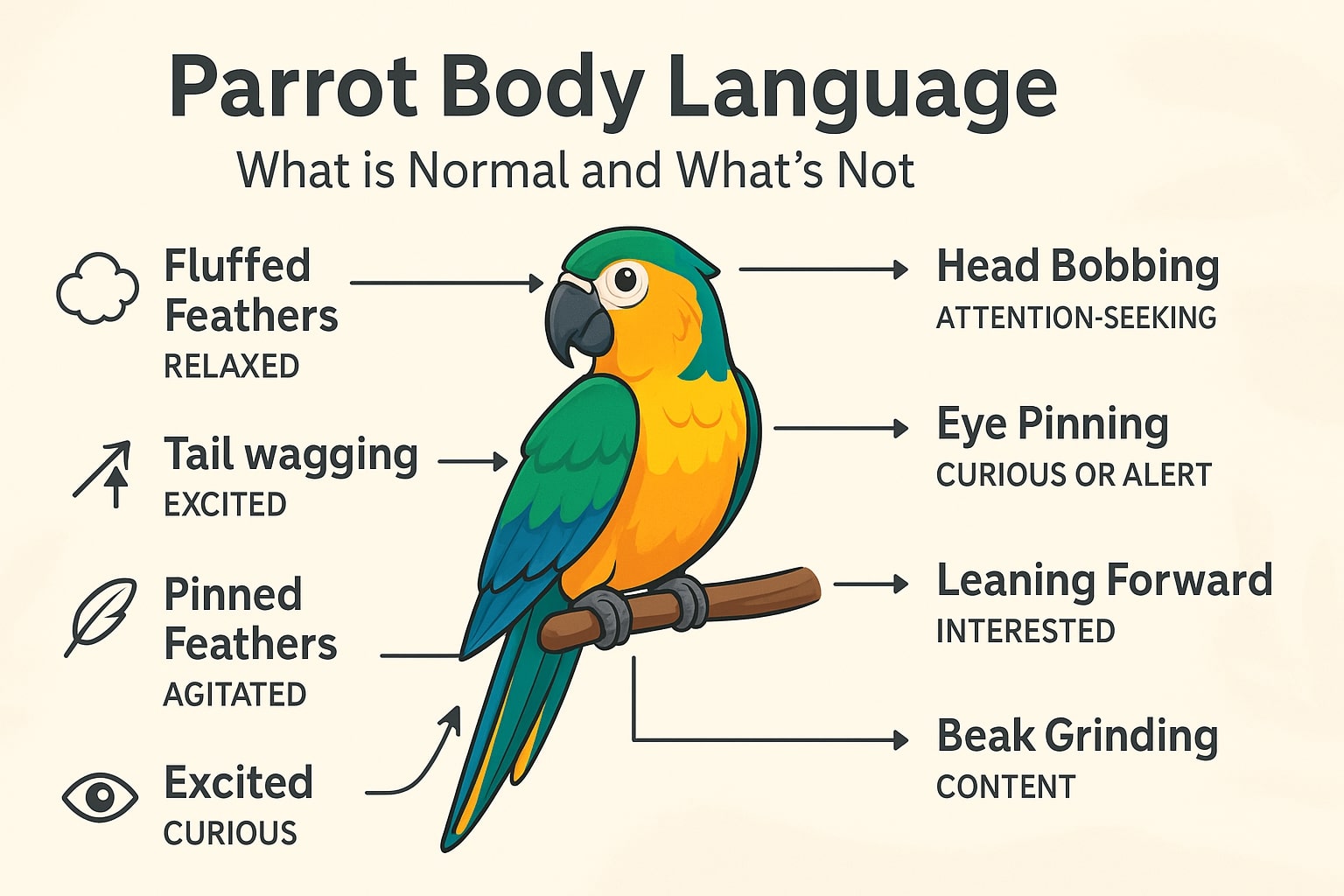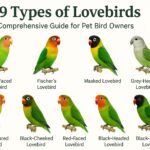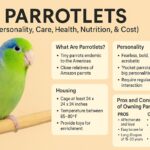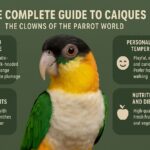Understanding your parrot’s body language is essential for building a strong relationship with your feathered companion. Unlike humans who rely heavily on verbal communication, parrots express their emotions, needs, and intentions through a complex system of physical signals.
Learning to read these signals correctly can help you respond appropriately to your bird’s needs and recognize when something might be wrong with their health or emotional state.
Understanding Basic Parrot Communication
Parrots are naturally expressive creatures that have evolved sophisticated ways to communicate with their flock members. In the wild, clear communication can mean the difference between life and death, so these birds have developed an intricate language of postures, movements, and vocalizations. When you bring a parrot into your home, you become part of their flock, making it crucial to understand what they’re trying to tell you.
Most animals are more honest than humans in their communication, rarely hiding their true feelings or intentions1. This directness makes parrot body language relatively reliable once you know what to look for. However, the key lies in understanding that context matters significantly when interpreting these signals. The same movement might mean different things depending on the situation, the bird’s recent experiences, and their overall environment.
Reading a parrot’s body language requires patience and careful observation. Each bird is an individual with their own personality quirks and communication style. What might be normal for one parrot could be unusual for another. Building familiarity with your specific bird’s patterns and behaviors will help you become more accurate in interpreting their signals over time.
Normal Wing and Feather Signals
One of the most common and heartwarming displays you’ll see from your parrot involves their wings. When a parrot stretches out one wing while looking toward you, they’re essentially saying hello. This greeting often comes with a curled claw and stretched leg on the same side as the extended wing. This behavior shows contentment and pleasure at seeing you again.
Feather positioning tells you a great deal about your parrot’s emotional state. A fluffed appearance typically signifies relaxation or sleepiness, while sleek, smooth feathers suggest contentment. When you see your bird with slightly ruffled feathers during quiet moments, this usually indicates they’re comfortable and at ease in their environment.
Another positive greeting signal involves feathers fluffing up combined with tail wagging1. A parrot that rapidly flips their tail is most likely happy to see you. Some species, particularly caiques, might even combine this with bouncing movements to show their excitement. This bouncing behavior is a completely normal way for parrots to express unfiltered excitement and pleasure.
However, pinned feathers along the back can indicate heightened excitement or agitation2. When feathers are pressed tightly against the body, especially along the back and neck, your bird might be feeling overstimulated or stressed. Learning to distinguish between relaxed fluffing and tense pinning will help you gauge your parrot’s comfort level.
Outstretched wings often signal playfulness or a desire for interaction2. When combined with relaxed body posture and normal vocalizations, this indicates your bird wants to engage with you. Conversely, tucked wings typically show relaxation or a sense of security. Birds often tuck their wings close to their bodies when they’re settling down for rest or feeling safe in their environment.
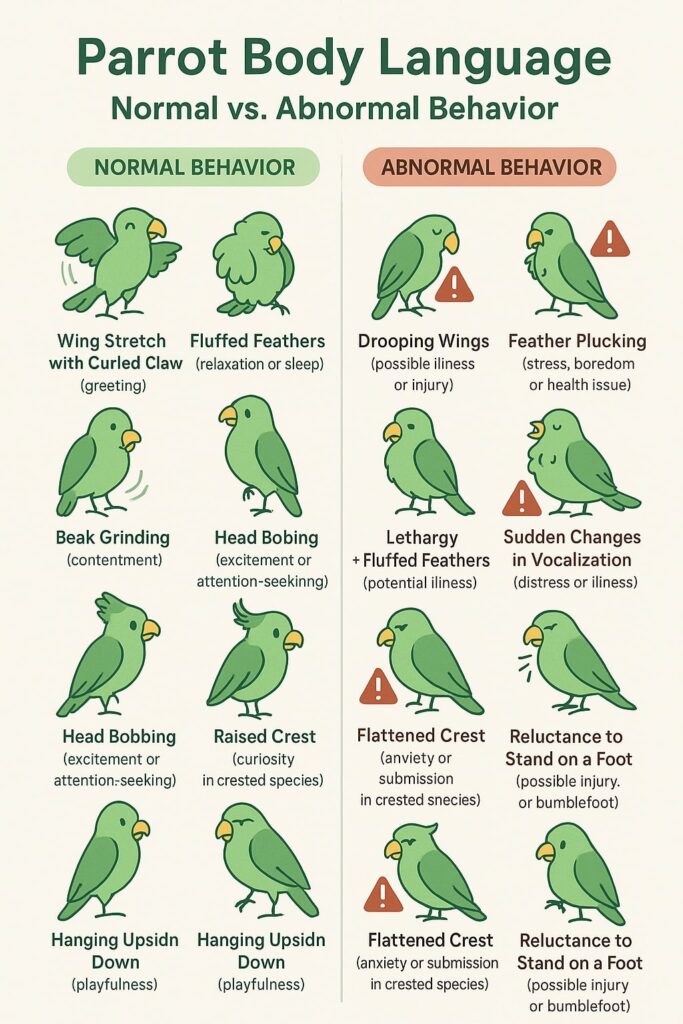
Head, Eye, and Crest Communications
The head region provides some of the most detailed information about your parrot’s state of mind. Eye contact plays a particularly important role in parrot communication. Dilated pupils often signify excitement or interest, while narrowed pupils might indicate unease or potential aggression2. However, avoid prolonged direct eye contact with your parrot, as they might interpret this as a challenge or threat.
For crested species, the position of their crest feathers offers clear emotional indicators. A raised crest often signals curiosity or excitement, while a flattened crest might suggest anxiety or submission. Watching how your bird’s crest moves in different situations will help you understand their comfort level and emotional responses.
Head bobbing serves multiple purposes in parrot communication. It can indicate excitement, a desire for attention, or even mating behavior in some contexts. Young parrots often bob their heads when they want food, mimicking the begging behavior they would show to their parents. Adult birds might use head bobbing as a way to get your attention or show enthusiasm about something happening in their environment.
Leaning forward typically shows engagement and interest in what’s happening around them. A bird leaning toward you or toward an object is demonstrating curiosity and alertness. In contrast, leaning away may indicate wariness or discomfort with the current situation. This backward leaning often appears when birds encounter something new or potentially threatening.
Tail Movement Interpretations
Tail movements provide valuable insights into your parrot’s emotional state and intentions. Scientific research has identified various functions for tail movements in birds, including communication with other birds, predator detection, and social signaling. Understanding these movements helps you better interpret your bird’s messages.
Tail fanning typically expresses curiosity or intrigue. When your parrot spreads their tail feathers wide, they’re usually investigating something interesting in their environment. This behavior shows alertness and engagement rather than fear or aggression.
Rapid tail flipping, as mentioned earlier, generally indicates happiness and excitement1. This quick, repeated movement often accompanies other positive signals like fluffed feathers or wing stretching. Some parrots will wag their tails almost like dogs when they’re particularly pleased to see their favorite humans.
Vertical tail movements, sometimes called tail flicking, can serve different purposes depending on the context. In some cases, this might be a way of maintaining balance, while in others it could be a form of communication. Observing when and how often your bird performs these movements will help you understand their specific meaning.
Beak and Vocal Behaviors
Beak movements offer another window into your parrot’s emotional state. A relaxed, slightly open beak suggests comfort and contentment2. This natural position indicates your bird feels safe and unstressed in their current environment.
Rapid beak grinding often signals contentment or relaxation2. Many parrots grind their beaks before settling down for sleep or during quiet, peaceful moments. This behavior is completely normal and actually indicates your bird feels secure enough to relax fully.
Beak clicking serves as a greeting signal when you enter the room. Parrots may click at you to acknowledge your presence and show they’re content with your arrival. This friendly gesture often combines with other positive body language signals.
However, clacking sounds might convey excitement or anxiety depending on the situation. Fast, sharp beak clacking combined with tense body posture could indicate stress or overstimulation. Learning to distinguish between content grinding and anxious clacking helps you respond appropriately to your bird’s needs.
Standing and Perching Positions
How your parrot positions themselves on their perch reveals important information about their comfort level and health. Standing on one leg is completely normal behavior that occurs when birds are happy and content. Many parrots even sleep in this position, often tucking the raised foot into their belly feathers for warmth.
This single-leg stance also helps birds conserve body heat and gives one foot a rest. However, if you notice your bird consistently favoring one foot or showing reluctance to put weight on a particular foot, this could indicate injury or a condition like bumblefoot, which requires veterinary attention.
Some parrots enjoy standing or hanging upside down in their cages. While this might look concerning to new bird owners, it’s actually a playful behavior that demonstrates your bird’s acrobatic abilities and comfort in their environment. Not all parrots perform this trick, but those who do are simply entertaining themselves and showing off their physical capabilities.
Recognizing Problem Signals
While many parrot behaviors are perfectly normal, certain signals indicate potential problems that require attention. Drooping wings can be normal after bathing, as birds use this position to help water run off their feathers. However, persistent wing drooping without a clear cause like recent bathing might suggest illness or injury.
Excessive feather plucking or aggressive preening goes beyond normal grooming behavior and often indicates stress, boredom, or health issues. While regular preening is essential for feather maintenance, obsessive plucking that creates bald patches requires intervention and possibly veterinary consultation.
Changes in vocalization patterns can also signal problems. While parrots naturally make various sounds throughout the day, sudden increases in screaming, complete silence, or unusual vocalizations might indicate distress, illness, or environmental stressors.
Lethargy combined with fluffed feathers and reduced activity levels often suggests illness. Healthy parrots are typically active and alert during their waking hours. A bird that remains puffed up and inactive for extended periods needs immediate veterinary attention.
Building Better Communication
Developing strong communication with your parrot requires consistent observation and appropriate responses to their signals. When your bird displays positive body language like wing stretching or tail wagging, acknowledge their greeting with gentle words or treats. This positive reinforcement encourages continued communication.
Respect your parrot’s signals when they indicate they need space. If your bird leans away, pins their feathers, or shows other signs of discomfort, give them time to relax rather than forcing interaction. Building trust means honoring their communication even when it means stepping back.
Creating a stable routine helps your parrot feel secure and more likely to communicate openly. Birds thrive on predictability, and knowing what to expect helps reduce stress and encourage natural behaviors. Regular feeding times, play sessions, and quiet periods all contribute to better communication.
Environmental factors significantly impact your parrot’s body language and communication patterns. Ensure their cage placement provides both social interaction and quiet retreat spaces. Proper lighting, temperature, and noise levels all influence how comfortable your bird feels and how clearly they communicate their needs.
Conclusion
Understanding parrot body language creates a foundation for a healthier, happier relationship with your feathered companion. By learning to recognize normal behaviors like wing stretching, tail wagging, and content beak grinding, you can better appreciate when your bird is communicating positive emotions. Equally important is recognizing when their signals indicate stress, illness, or discomfort, allowing you to respond appropriately and seek help when needed.
Remember that each parrot is unique, and building fluency in their specific communication style takes time and patience. Focus on observing patterns in their behavior and responding consistently to their signals. This investment in understanding will pay dividends in the form of stronger trust, better health monitoring, and a more enriching relationship for both you and your parrot.
The key to successful parrot communication lies in respecting their natural language while providing appropriate responses that meet their physical and emotional needs. With practice and attention, you’ll develop the skills needed to truly understand what your parrot is telling you through their remarkable body language.
- Parrotlets (Personality, Care, Health, Nutrition, & Cost) - June 20, 2025
- Caique (Personality, Care, Health, & Nutrition) - June 20, 2025
- The Complete Guide to Golden Retrievers - June 9, 2025
